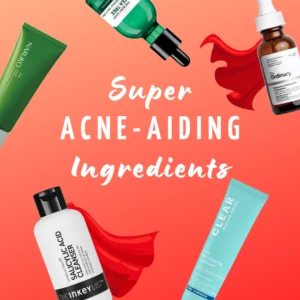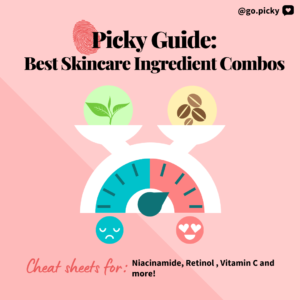Do you have acne-prone, congested or oily skin? If you said yes to the above and have yet to incorporate salicylic acid-based product in your skincare routine, you’re in luck. In this article, we’ll talk more about what salicylic acid really is, and spill the tea as to why so many people are swearing by this hero ingredient!
What is salicylic acid?
Salicylic acid is a type of oil-soluble BHA (beta-hydroxy acid). These two terms are often used interchangeably. It is commonly found in over the counter (OTC) skincare products at a range of between 0.05% – 5% (up to 0.5% in Korean skincare). It is commonly obtained from the bark of the willow and wintergreen leaves.
Other forms of salicylic acid
There are some derivatives and related ingredients that claim to have similar efficacies on the skin. In some K-Beauty products, especially, you can see ingredients such as betaine salicylate, willow bark extract, or beta hydroxybutanoic acid being referred to as a BHA.
How does salicylic acid work, and what are its benefits?
Salicylic acid is a really multifunctional ingredient that can address multiple skin concerns! Some of its key properties include:
- Removing dead skin cells
The ingredient primarily works as an exfoliator that “unglues” and removes dead skin cells. Due to its oil-solubility, it can naturally penetrate into the deeper parts of our pores, therefore helping to clear our pore lining. It allows our skin’s natural oils to flow more easily, while at the same time preventing the formation of whiteheads or blackheads.
- Fighting acne
On top of preventing formation of dead skin cells that may cause future breakouts, it also has antibacterial properties that help to fight off acne-causing bacteria.
- Controlling sebum production
Using salicylic acid over an extended period of time has also been proven to regulate and control sebum production. Oily skin types, rejoice!
- Soothing irritated skin
Lastly, this hero ingredient also has anti-inflammatory properties that help to calm down skin irritation and redness.
Who can benefit from it?
Generally, salicylic acid presents benefits to people of all skin types. However, people with the following skin concerns have the potential to maximize its benefits:
- Oily skin
Do you feel that your skin looks greasy and oily in the middle of the day or in pictures? Do you experience a lot of skin congestion and acne? If you are nodding as you read this, you most probably have oily skin. If you are still unsure, make sure to log into Picky and complete our Skin Type Analyzer to determine your skin type.
- Acne-prone skin
If you have oily skin, your chances of having acne are mostly doubled, thanks to overproduction of sebum being one of the major causes of acne. Fortunately, it helps with treating comedones (better known as whiteheads/blackheads) and inflammatory acne.
- Enlarged pores
Your pore size is greatly determined by genetics, skin elasticity and also sebum production. Since the ingredient can help to clear your pores and control sebum production, it can also help with minimizing the appearance of large pores over time.
- Hyperpigmentation
Acne scars can be problematic because they may take a while to treat. Exfoliating can help remove the top layer of your skin and reveal newer skin cells. This process can gradually fade hyperpigmentation and make your skin appear more fresh and even.
- Dull and congested skin
If your skin always looks tired with an uneven texture, you may be not exfoliating your skin enough. As our body ages, our skin also loses its capability to naturally exfoliate dead skin cells. This makes it easier for our skin to look tired and dull. Its exfoliating properties helps to fight skin dullness and counter the effects of aged skin.
Who should avoid it?
There has insufficient data to prove both the safety and harmful effects of topical salicylic acid in OTC products. However, to err on the side of caution, we have filtered out all products containing salicylic acid via Picky’s pregnancy-safe filter. We recommend you to speak to your doctor if you are considering to use it during pregnancy or breastfeeding.
How often should you use salicylic acid and what should you expect?
Everyone may react differently to salicylic acid. Since every product contains a different concentration, make sure to follow the directions of use on each product.
However, if you are new to skincare, you may want to introduce it slowly into your routine. Start by using salicylic acid-based products 2 to 3 times in a week. Following this, you may wish to increase its frequency as your skin adjusts to the ingredient. It is normal for your skin to purge when you first start on your salicylic acid journey, since it helps to improve the rate of your skin cell turnover.
To minimize the chances of purging, make sure to moisturize your skin and use the proper amount of sunscreen, as salicylic acid increases your skin’s sensitivity to the sun.
Too much of a good thing can be bad, so make sure to not overdo it — overuse can lead to over-exfoliation, which ultimately damages your skin barrier!

Takeaway:
Does salicylic acid sounds like a must-have in your skincare routine? Check out the Picky app and use the salicylic acid filter to find related products! We will be picking some of our favorite salicylic acid-based product in our upcoming posts, so don’t forget to follow us on Instagram for more updates.

















One Response
Can I combine salicylic acid with hyaluronic acid serum?